A central part of GEO’s Mission is to build the Global Earth Observation System of Systems (GEOSS). GEOSS is a set of coordinated, independent Earth observation, information and processing systems that interact and provide access to diverse information for a broad range of users in both public and private sectors. GEOSS links these systems to strengthen the monitoring of the state of the Earth. It facilitates the sharing of environmental data and information collected from the large array of observing systems contributed by countries and organizations within GEO. Further, GEOSS ensures that these data are accessible, of identified quality and provenance, and interoperable to support the development of tools and the delivery of information services. Thus, GEOSS increases our understanding of Earth processes and enhances predictive capabilities that underpin sound decision-making: it provides access to data, information and knowledge to a wide variety of users.
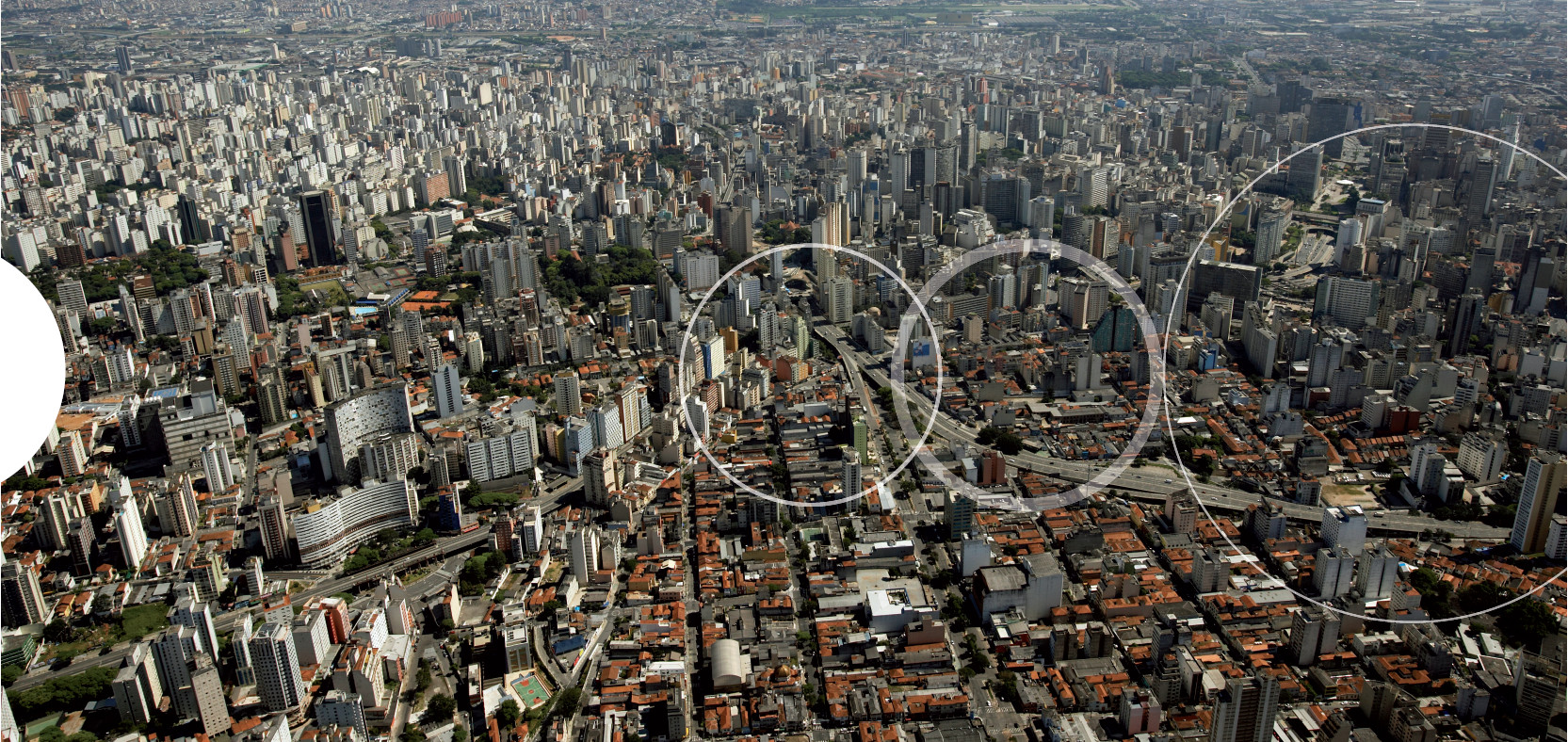

This ‘system of systems’, through its GEOSS Platform (former GCI), proactively links together existing and planned observing systems around the world and support the need for the development of new systems where gaps currently exist. It will promote common technical standards so that data from the thousands of different instruments can be combined into coherent data sets.
The ‘GEOSS Portal’ offers a single Internet access point for users seeking data, imagery and analytical software packages relevant to all parts of the globe. It connects users to existing data bases and portals and provides reliable, up-to-date and user friendly information – vital for the work of decision makers, planners and emergency managers.
For users with limited or no access to the Internet, similar information is available via the ‘GEONETCast’ network of telecommunication satellites.
The Global Earth Observation System of Systems’ Platform (former GEOSS Common Infrastructure, or GCI) proactively links existing and planned observing systems around the world and supports the development of new systems where there are gaps. The GEOSS Platform promotes the use of common technical standards so that data from thousands of different instruments can be combined into coherent data sets.
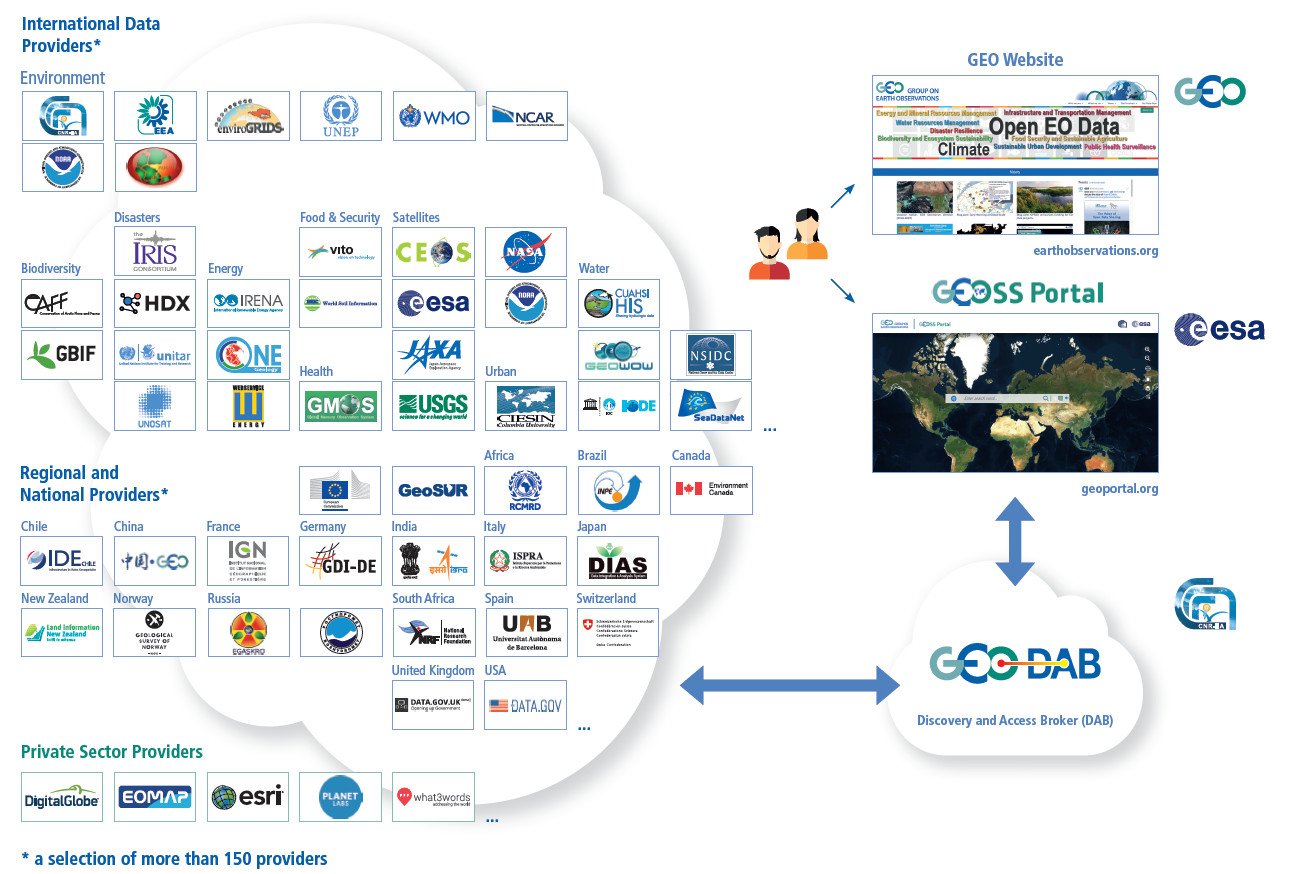

The GEOSS Portal offers a single Internet access point to Earth observation data, information and knowledge from all over the world for users with different backgrounds and from different disciplines. The Portal has an intuitive, easy-to-use interface to discover, access and use the ever-growing quantities of GEO resources. Through the Portal, the GEOSS Platform connects the users to the wealth of heterogeneous collections of databases and other portals and provides reliable, up-to-date and user friendly (current and historical) information – vital for the work of decision/policy makers, planners and emergency managers. Both the public and private sector but as well citizens are served.
Users can discover data considering temporal, thematic and geographic search criteria, and apply progressive filtering to retrieve, quickly and accurately, the resources they need. Information regarding the data can be inspected either via an information window or visually on different background maps if enabled before download.
For users with limited or no access to the Internet, there are regions making similar information available via the satellite service, GEONETCast. The GEOSS Platform is a brokering infrastructure.
The GEO Discovery and Access Broker (GEO DAB) is the primary mechanism by which all data and information is discovered and accessed. The GEO DAB implements the necessary mediation and harmonization services through Application Program Interfaces (APIs). These APIs allow data providers to share resources without having to make major changes to their technology or standards.
Presently GEOSS Platform brokers more than 150 autonomous data catalogs and information systems, useful for the different GEO Societal Benefit Areas including data from: CAFF, Data.gov, Data.uk, EEA, GBIF, Iris, JRC Open Data catalog, NASA, NCAR, NOAA, OCHA HDX, RCMRD, UNEP, UNOSAT, USGS, Web Energy Services, WMO WIS and many more.
Data providers are constantly being added and brokered, according to user needs, thematic and geographic balance of the data and relevance of resources shared.
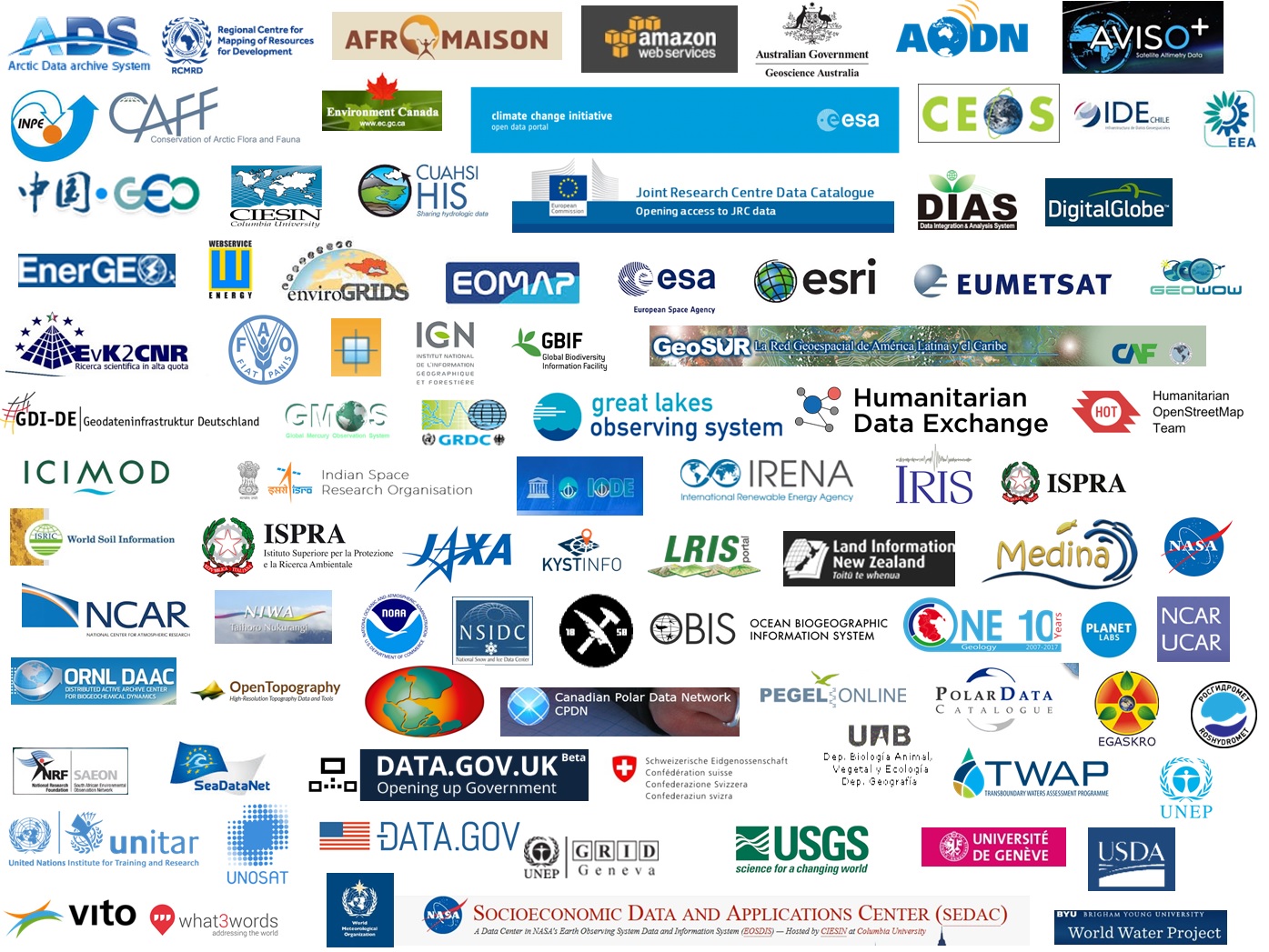

The GEOSS Portal provides a map-based graphical user interface for users to discover and access Earth Observation data and resources from different providers from all over the world.
The portal is implemented and operated by the European Space Agency and provides a single Internet access point to the ever-growing quantities of heterogeneous collections of Earth observations from satellites, airplanes, possibly drones and in-situ sensors at global, regional and local scale.
The GEOSS Portal - as part of the Global Earth Observation System of Systems (GEOSS) - serves a wide variety of users from data scientists to decision and policy makers, within the public and private sector, and considers as well citizens as part of their target community. The portal provides generic as well as more community-specific search capabilities supporting users from different domains, or thematic areas, interested in particular societal benefits of application of Earth observations.
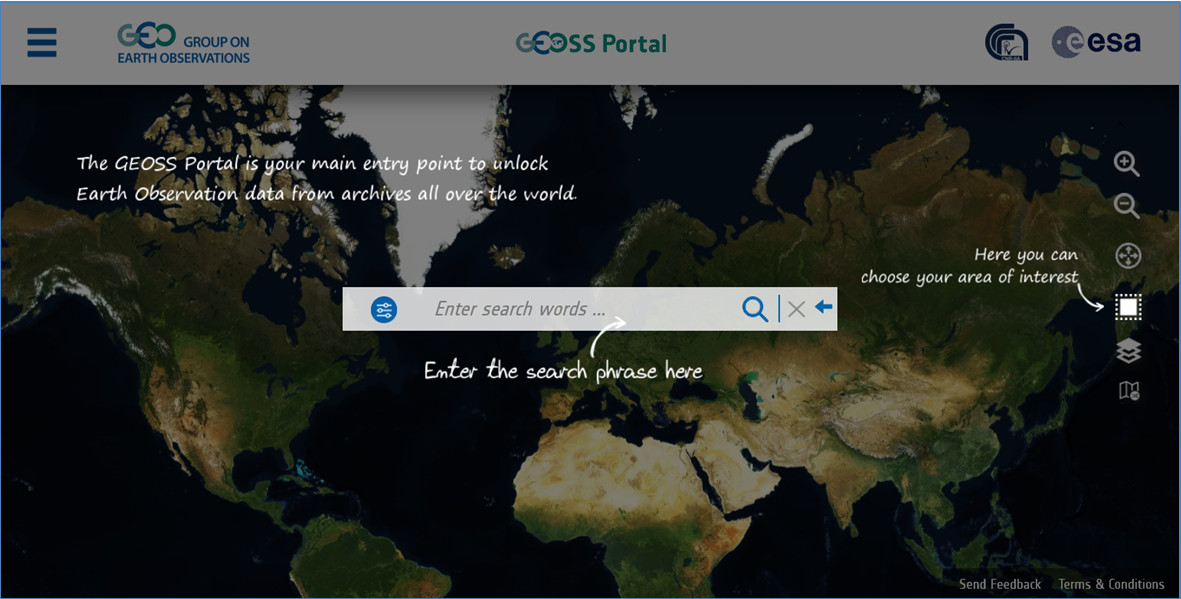

The GEOSS portal - available at www.geoportal.org - has undergone relevant updates during 2016 and early 2017.
It was completely restyled with the objective to provide a more intuitive interface and align it with the new GEO brand.
At opening of the portal, you will see: a map of the world with in the middle a simple key-word based search panel; in the upper right corner, a series of icons for basic GIS (Geographical Information System) functionality including zooming, recentering, layers handling, and area of interest and basemap selection; in the lower right corner, links for providing feedback and accessing information regarding terms and conditions and, in the upper left corner, a button for accessing the menu with options to sign-in, obtain information regarding the portal, data providers, how to contact the Help-Desk, go to a personalised workspace and retrieve information regarding popular (most used) searches. Panning can be done by simply moving the map with your mouse (pad).
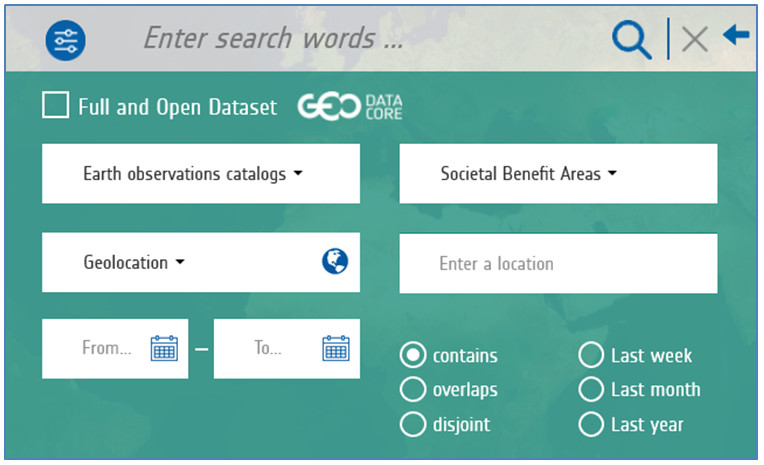

The multi-criteria search panel can be unfolded selecting the most-left icon in the simple key-word based search panel.
As part of a multi-criteria search, a user can:
 coordinates;
coordinates; API;
API;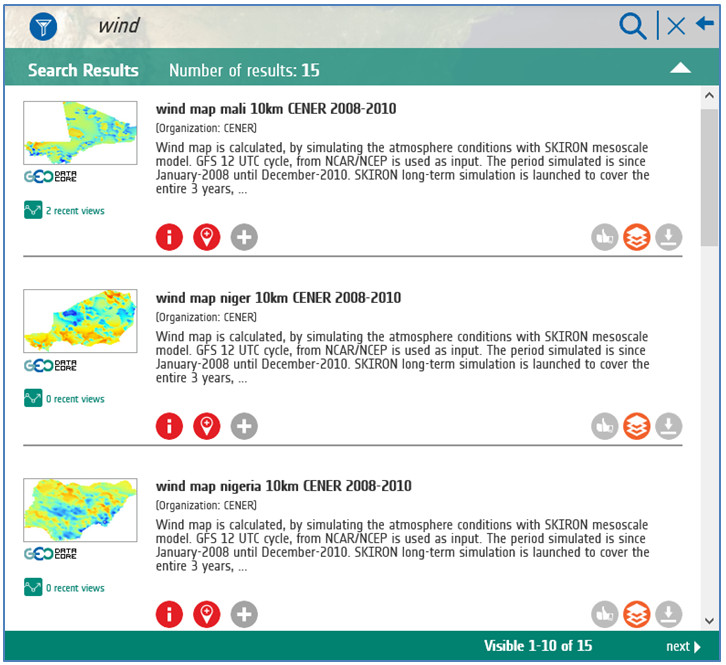

Results of a query are displayed in a results panel.
A default number of ten results is displayed; users can easily access the next (or previous) ten results by clicking the next (or prev) arrow at the bottom of the panel. Each result item shows a title, a brief description, a browse image (if available), the GEOSS Data CORE flag (which means that the data is freely and openly accessible, according to the GEOSS Data CORE principles), and a series of icons corresponding to applicable functions.
More precisely, the following functions may be available (depending on the provider):
For collections, the collection start date is also displayed.
The GEOSS portal provides the possibility to narrow down the search results to a smaller set by applying filters. The type of filters depends on the actual search and results.


Default filters are available for most search results and include filtering on keywords, format, source, protocol and organization. Filtering is progressive, implementing an 'AND' operation and not an 'OR'. For each filter only one value can be selected.
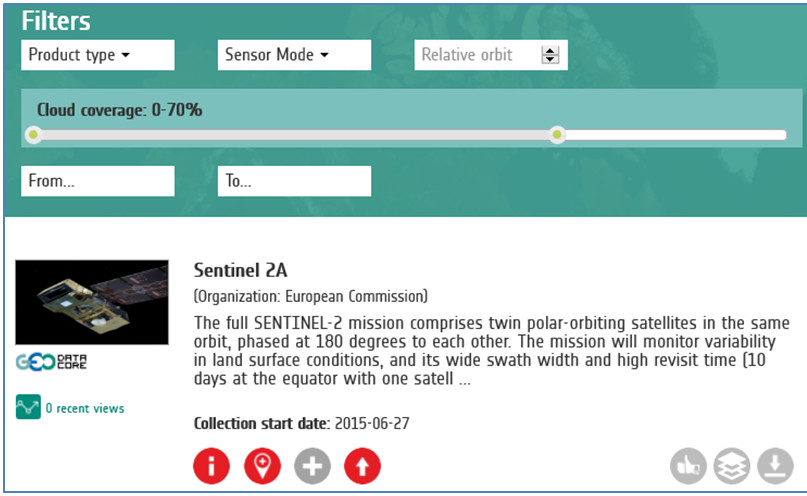

Smart filters are implemented for some of the result types. For example, a smart filter considering a combination of cloud coverage, product type, sensor mode and relative orbit has been implemented for data from the Sentinel 2 and the Landsat imagery, and a smart filter considering product type, sensor polarisation, sensor mode, sensor swath and relative orbit has been implemented for Sentinel 1 data.
Other smart filters are available for earthquake events.
The GEOSS Portal is the front-end component of the GEOSS Platform (former GCI) providing access, through the GEOSS Platform Middleware, i.e. the GEO Discovery and Access Broker, to hundreds of millions of data records from more than 150 GEO Resource Providers. Numbers are growing every day.
The Portal Development framework is based on LifeRay 6.2, Openlayer 3.
The application programming interface used to interface with the GEO DAB is based on OpenSearch; CSW is used for metadata.
The GEOSS Portal is continuously subject to evolutions in response to the evolving user requirements.
Upcoming evolutions consider layer handling, processing services, new smart filters, feedback data model, views.
One of the evolutions currently under implementation regards the reuse GEOSS Portal Look & Feel and functionalities. Mirrored and customisable GEOSS Portal sites will be available for SBAs, Flagships, Initiatives, and GEO Communities at large, to better serve the specific community interests. In addition to this, a freely available instantiation of selected GEOSS Portal widgets will be made available for possible customization. This will be accomplished by publishing portal code parts (widgets) wrapped up in API.
Follow this link:
https://www.youtube.com/channel/UCZwhJZI76s7K9eAcBXAPyrw


GEO DAB is one of the two main European Contributions to GEOSS Platform (former GCI), transparently connecting GEOSS Portal to the resources shared by the GEOSS Providers.
GEO DAB scope is to simplify cross and multi-disciplinary discovery and access of disparate data and information.
GEO DAB is a brokering framework that interconnects hundreds of heterogeneous and autonomous supply systems (the enterprise systems constituting the GEO System of Systems) by providing mediation, harmonization, and transformation capabilities.
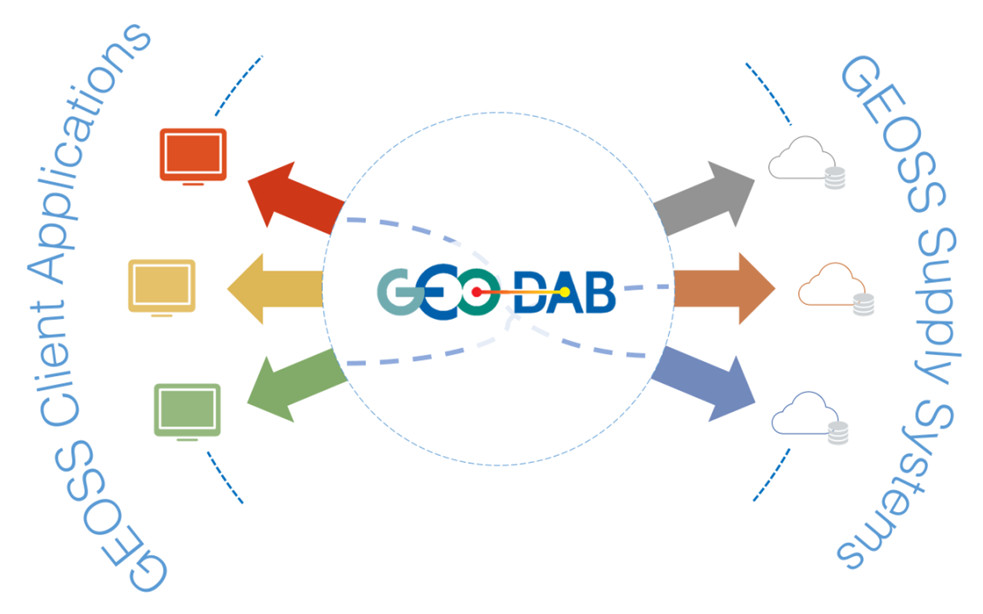

The GEO DAB APIs can be used to discover and access GEOSS resources via the GEOSS Platform. GEO DAB publishes three types of APIs:
These APIs are used by the GEOSS Portal to discover, visualize and access GEOSS resources. Besides, the APIs are used to define and utilize SBA-specific views of the GEOSS resources, i.e. a customized subset of GEOSS resources targeting the needs of the SBA communities.
For new data providers, see below the GCI Registration and Brokering Process
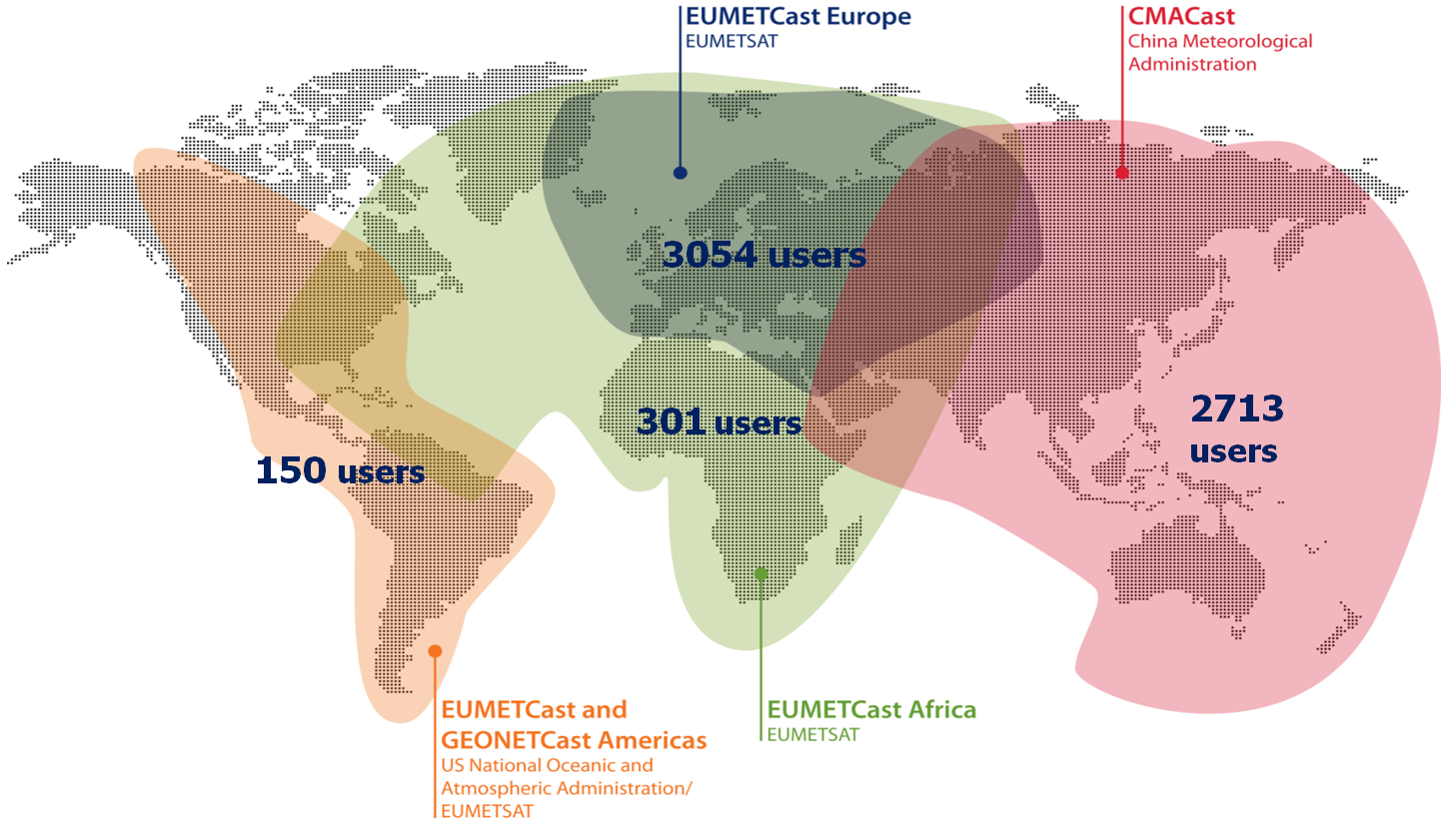

GEONETCast is a global network of sustained and cost-effective satellite-based dissemination systems. It delivers Earth observation (EO) data and products to and from GEO community activities, initiatives and flagships on a routine basis.
GEONETCast is a GEO foundational task and an integral part of the GEOSS Common Infrastructure (GCI). It facilitates access to data to support the GEO Societal Benefit Areas. It contributes to the implementation of GEOSS, as defined in the GEO 2016–2025 Strategic Plan.
GEONETCast is based on collaboration between China (CMA), EUMETSAT and the US (NOAA). Its architecture is open and can accommodate other partners.
Its operation is based on various regional broadcasting systems, with established routine data exchange between them. It relies on infrastructure put in place, and sustained, by meteorological agencies. This creates synergies and complementarities between GEO-related data and routine data delivered for operational meteorology.
GEONETCast currently serves approximately 6,000 users in 169 countries.
GEONETCast is made available to support GEO objectives. It focuses on providing support, in term of data access, to and from GEO Flagships, Initiatives and Community Activities, considering priorities for each region.
GEONETCast is also used for ad-hoc data transmission where high speed landlines and/or internet are not available, or in regions where terrestrial communication lines have been disrupted by disasters.
GEONETCast is able to disseminate high volume data worldwide, even to areas with limited access to the internet.
GEONETCast delivers a wide range of EO satellite data and products, generated by CMA, EUMETSAT, NOAA, and many third-party providers. The range of products covers applications relating to weather forecasting, atmospheric composition, marine meteorology, oceanography, and land management.
Building capacity is one of GEONETCast’s achievements. In addition to providing data access, GEONETCast, through its Training Channel, provides opportunities for users to further exploit the data they receive.
The Training Channel:
GEONETCast, through its Disaster Channel, is available to deliver products in support of the International Charter on Space and Major Disasters.
Discovering Data
Users wishing to explore the range of environmental data available through GEONETCast will find the full list of products in the Product Navigator and the GEO Web Portal.
Several regional centres are responsible for establishing the satellite-based regional dissemination system — based on Digital Video Broadcast (DVB) technology — and providing complementary services to a common user community.
GEONETCast is currently available in Europe, Africa, the Americas and Asia-Pacific region.
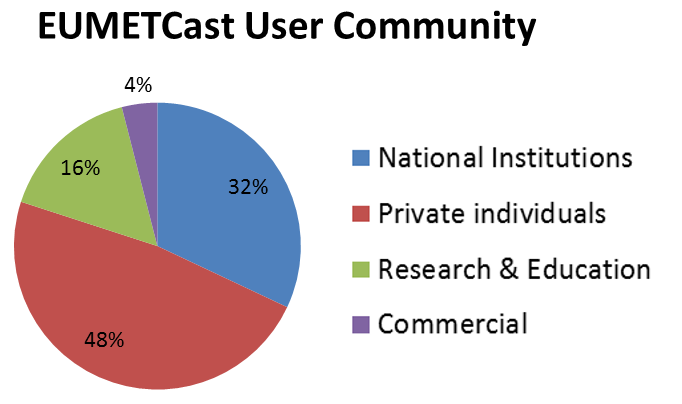

EUMETCast is the EUMETSAT contribution to GEONETCast, with coverage over Europe and Africa and the Americas. Established in 2004, EUMETCast has more than 4,000 registered reception stations with more than 3,400 users benefiting from the environmental data it provides.
The EUMETCast user community is diverse ranging from operational meteorological forecasting centres to enthusiastic amateurs interested in remote sensing data. The large number of private individuals receiving EUMETCast is testimony to the ease with which a station can be set-up.
CMACast is the China Meteorological Administration’s contribution to GEONETCast, with coverage over the Asia-Pacific region. CMACast utilises the AsiaSat 4 satellite beam to broadcast data and products to more than 2,500 users. As well as serving the People’s Republic of China, CMACast is used in 20 countries in the Asia-Pacific region.
GEONETCast Americas is the Western Hemisphere component of GEONETCast, operated by NOAA. It provides data and products to more than 60 users in Central and South America and the Caribbean region.
For the users, GEONETCast is a user-friendly, and low-cost information dissemination service.
A typical GEONETCast reception station comprises a standard PC, a DVB reception device (internal or external), and a satellite off-set antenna fitted with a digital universal V/H LNB for Ku-band, or fitted with a circular polarisation feedhorn, bandpass filter and special LNB for C-band.
To decode and decrypt the EUMETCast data stream, EUMETCast Client Software and a EUMETCast Key Unit (EKU) are also required.
The cost of reception stations is kept to a minimum by using industry open standards as much as possible, resulting in an adaptable front-end solution to users' applications.
In addition to the front-end equipment, proprietary client software used to decode the DVB signal and data processing software will be required. These software applications are commercially available.
User registration steps are unique to each network provider. Users interested in receiving products and services delivered via GEONETCast should register with GEONETCast network provider covering their geographical location:
Feedback is welcomed, from:
Please use the GEONETCast Feedback Form (PDF, 47 KB).